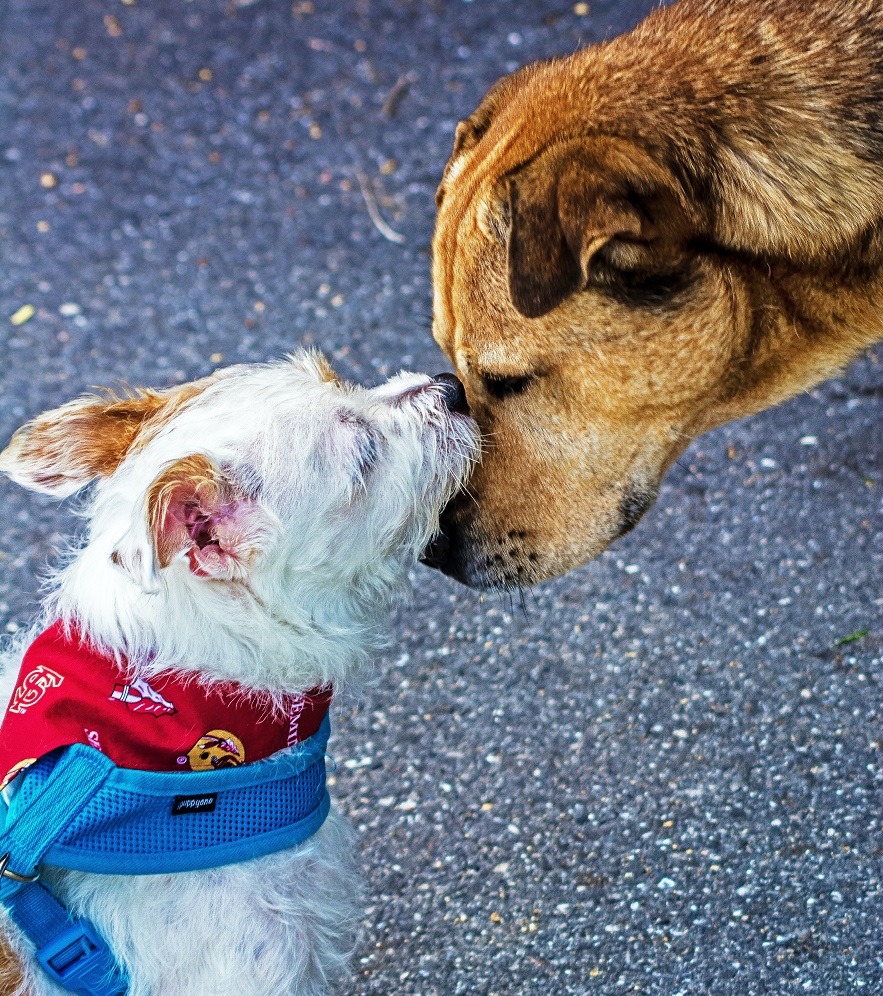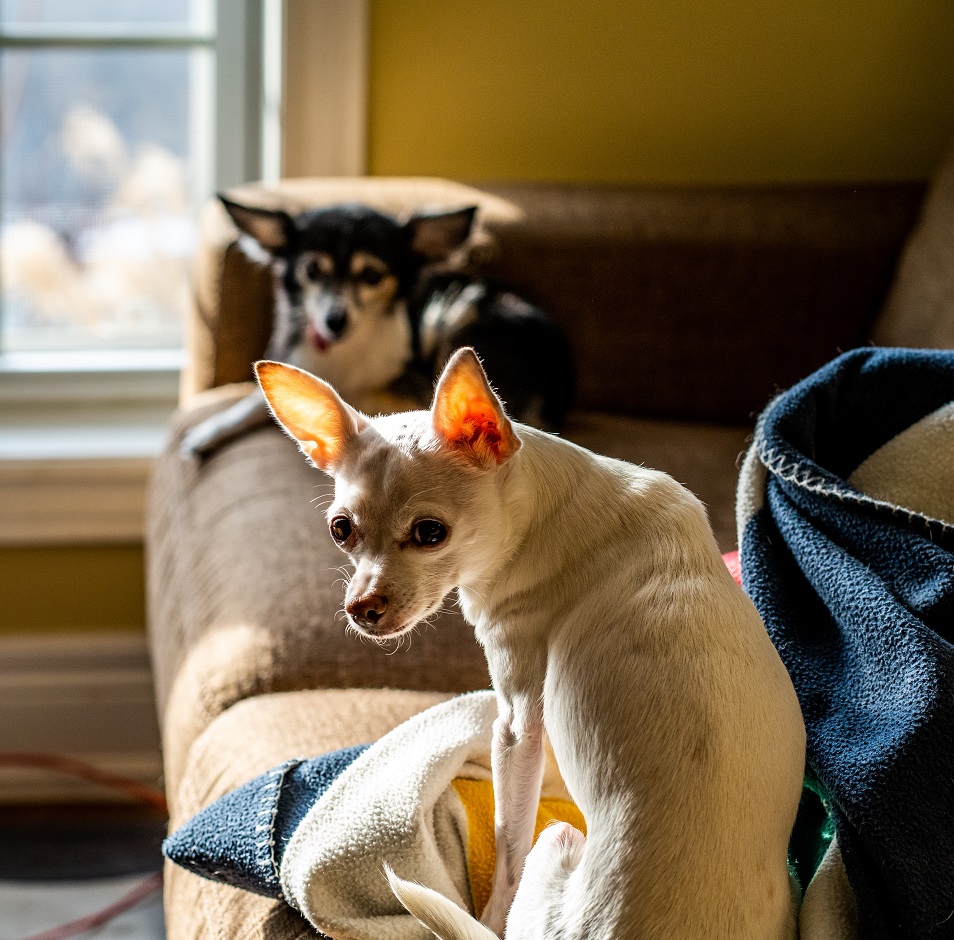 You’ve heard people generalize dogs by size, right? “Get a little dog — you can take them everywhere” or “Big dogs belong in the country where they’ll have room to run.” There are a lot of long-standing beliefs about both giant and pint-sized pups. Some are born of actual observations of canine health and behavior, but others have grown out of oft-repeated myths, trending fads (purse puppies!), or over-generalizations based on how we feel dogs “ought to” fit into our homes or culture. These assumptions can stand in the way of sensible choices about dog breeds and dog training.
You’ve heard people generalize dogs by size, right? “Get a little dog — you can take them everywhere” or “Big dogs belong in the country where they’ll have room to run.” There are a lot of long-standing beliefs about both giant and pint-sized pups. Some are born of actual observations of canine health and behavior, but others have grown out of oft-repeated myths, trending fads (purse puppies!), or over-generalizations based on how we feel dogs “ought to” fit into our homes or culture. These assumptions can stand in the way of sensible choices about dog breeds and dog training.
Some people may not consider adopting a particular breed of dog based on incorrect assumptions that link size with behavior. Or they might not think to consult a dog trainer for help with undesired behaviors in their own dog because, for example, “all small dogs bark.”
Let’s look at how to join the conversation when you hear people sharing these size-based behavioral stereotypes, and help dogs – and people – get the dog training support they need.
You can take tiny dogs anywhere
Small dogs are light and big dogs are heavy. So when it comes to mere physics, an 8-pound dog certainly should be easy to carry, right? It seems to follow that people who want to keep their dog constantly at their side should pick a tiny breed.
It’s certainly true that smaller dogs are lighter to lift than their larger-breed canine cousins. Unfortunately, because little dogs are so small and cute, their introduction to being lifted is sometimes abrupt and frightening. Big grabby human hands are predator-like, and the sensation of being swooped up into the air at high speed by a stranger can be distressing. Some smaller pups develop an early aversion to being picked up and may meet those intrusive hands with bared teeth, or yelp in fear even if they aren’t being hurt.
Every dog is an individual when it comes to enjoyment of travel, too. While socialization and gentle introduction to carriers, slings, and cars will help, just because a dog is tiny and can fit in a protective purse doesn’t mean they will necessarily enjoy a constant parade of new sights and sounds. In fact, a larger leashed dog who has more freedom to see and react to new things, and who can more easily see and take cues from you, can sometimes be a better travel buddy than a small luggable pup.
Instead of just assuming small breeds are “liftable” because they only weigh a scant handful of pounds, it’s best to patiently teach little dogs a cue that indicates they are about to be picked up. In fact, holding and lifting is a good training exercise for dogs of all sizes, so they aren’t taken by surprise when lifted up onto an exam or grooming table, carried after surgery, or assisted on stairs as a senior dog. Dogs may need to be confined to a bag or carrier while on public transportation, so urban dogs of any carriable size can benefit from training in being gently lifted and comfortably carried for short distances. Big dogs should be crate trained in case they ever need to travel in a confined space, in addition to the many other benefit of crate training a dog.
To introduce a dog to being held and carried, the lifter can place their hands near the dog and wait for the pup to turn to the side in acceptance before carefully holding or picking them up. Remind your clients that being lifted or carried can be uncomfortable for the dog even in the gentlest situations (imagine being scooped up as an adult human — it may be tolerable, but it’s seldom comfortable). With patience, and rewards, many dogs of small to medium-large size can learn to tolerate being lifted from the floor to a higher surface, over high obstacles, or down a set of stairs. Some small to medium-sized dogs even enjoy learning to jump in your arms on cue!
Still, even some little pups may prefer to keep all four paws on the floor. If a client mentions that they plan to carry their pint-sized pup with them everywhere, show them how to thoughtfully introduce their dog to a properly sized carrier, sling, or pouch, and how to watch for signs that their dog is really enjoying — not simply tolerating — their purse-height view of the world.
Big dogs need ‘room to run’ in the country
Truth or stereotype? Little dogs thrive in city apartments and big dogs need ‘room to run’ in the country. This statement generalizes both big dogs and rural living!
Big or small, city or country, the key to making a dog happy in a home of any size is to make sure their needs for training, play and exercise is met. A pet parent who jogs three urban miles morning and evening is better able to meet the needs of a big active dog than a country-dweller who has a long commute and is gone most of the day.
Contrary to the myth that big dogs “need a country home with room too to run,” many rural areas also have dog control laws – even leash laws – just like cities. Both country pups and city pups rely on their human guardians and a leash for safe fun and exercise. While certainly there is more square footage available for fenced yards in rural areas, installing a fence is just as expensive. A fenced yard in the country may not be much larger than a fenced yard in the suburbs, because the homeowner still has to pay for building and maintaining a dog-safe gated yard enclosure.
The urge to explore and stretch their legs also isn’t exclusive to big dogs. Plenty of little dog breeds have hunting ancestry. Terriers. dachshunds and beagles love exploring, sniffing and digging. An easily bored little dog might prefer a big rambling country home and long rural hikes with lots of exciting things to sniff, just like some large breed dogs.
In fact, some of the very largest dog breeds are big and powerful, but are satisfied with moderate exercise and don’t require long romping sessions of fetch every day. The biggest drawback to life in a small space with one of the lower-key giant breed dogs is that people have to step around them when they are stretched out to sleep. They can accidentally knock things over with a sweep of their tail, and also they need easy access to the outdoors without countless flights of stairs. But their needs can be met in both city or country homes, with the right human partner.
When it comes to what lifestyle, home size, or location is best for a dog, it is important to let people know that the decision is not just about whether the dog is big or small. It’s about what they were bred to do, the lifestyle their pet parents can offer them, and their own unique personality.
Little dogs are perfect couch companions
 It’s true that a tiny pup will take up less room on the couch and can curl up on your lap in that big overstuffed chair. But while a medium or large dog can easily step or hop up onto your furniture, a tiny dog can strain or even break a fragile leg constantly leaping up and down. Long-backed dogs like Dachshunds can wrench their backs. While these types of injuries aren’t exclusive to pint-sized pups (even a Labrador can step wrong and hurt themselves) it is a serious concern for small dogs with tiny bones and their enthusiastic tendency toward flying leaps.
It’s true that a tiny pup will take up less room on the couch and can curl up on your lap in that big overstuffed chair. But while a medium or large dog can easily step or hop up onto your furniture, a tiny dog can strain or even break a fragile leg constantly leaping up and down. Long-backed dogs like Dachshunds can wrench their backs. While these types of injuries aren’t exclusive to pint-sized pups (even a Labrador can step wrong and hurt themselves) it is a serious concern for small dogs with tiny bones and their enthusiastic tendency toward flying leaps.
It’s worth a little effort to train a small dog to wait for a cue to hop up or down from high places or learn to use a strategically placed ottoman or pet stairs. Dogs of any size who love to fly like Superman should be trained to walk down steps or jump down sedately from furniture to head off a future accident, especially as they grow older.
It’s more important to train big dogs than small ones
All dogs, big or small, benefit from training. The assumption that dog-training classes and big dogs go hand-in-paw is likely due to the sheer physical size of larger breeds. A poorly mannered German Shepherd intimidates other people. If a Shepherd leaps up or lunges, even in play, they can knock a person over. However, scratched legs and ruined clothes caused by a leaping Jack Russell Terrier are no picnic, either, and an unruly tiny dog can terrify a child and some adults, too. A little dog who is allowed to do as they please is in danger of running into life-threatening mischief. A small apartment dog who barks all day or chews at door frames risks additional rental fees and the ire of neighbors.
When you hear people wonder whether it’s worth investing in training classes for their small dog, don’t hesitate to point out the benefits. All dogs, regardless of size, will have a safer and happier home life if they are trained to keep all four on the floor when they greet strangers, walk calmly on a leash, and exercise their minds with interactive games.
Small dogs live longer than giant dogs
On average, this common belief is true. One study found that dogs under 20 pounds had an average lifespan of eleven years, while dogs over 90 pounds lived an average of eight.
Larger breeds also can suffer from conditions that are impacted by high activity, like ligament tears, dysplasia, arthritis, and bloat. These are expensive conditions to treat, and if a large senior dog cannot walk, their guardian may make the difficult decision to opt for euthanasia if they are unable to provide adequate care. (Luckily, there are now well-crafted slings on the pet market to help medium and large sized dogs who need a little extra support). When a small senior dog suffers from limited mobility, they can be more easily carried outside to enjoy the sunshine and relieve themselves. Some pet parents choose smaller dogs over larger ones, with end-of-life care in mind.
But here’s a brighter thought: If you hear a person mention they would love a giant breed dog but worry about their lifespan, point out that by training a dog from puppyhood – no matter their size – a pet parent gets extra value from their years together. With a well-mannered dog at their side, each day can be packed full of positive fun and adventures.
Learn to speak “Dog” with pups of every size and breed
A comprehensive education in dog training will help you teach people to separate fact from myth when it comes to dog breeds and sizes. It’s certainly a myth that online dog training is a lonely pursuit! With the Victoria Stilwell Academy Dog Trainer Course you not only get dynamic HD video-based, instructor-led self-paced online lessons, you also get real live people-time through weekly online meetings with your own dedicated personal Faculty Advisor and a private ‘study group’ online community. Look a little closer at our Online and In Person tracks of the Victoria Stilwell Dog Training Course. You can even download a course syllabus here!



